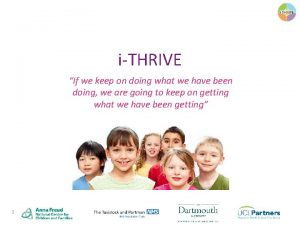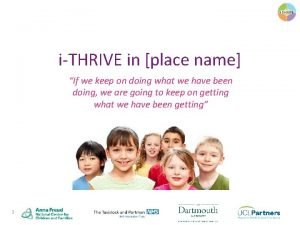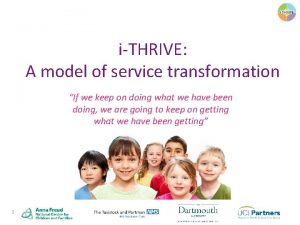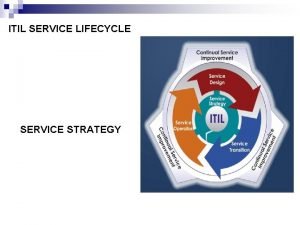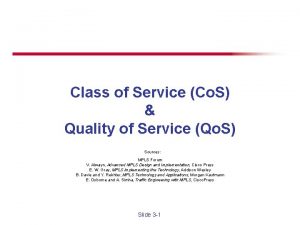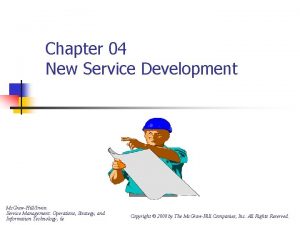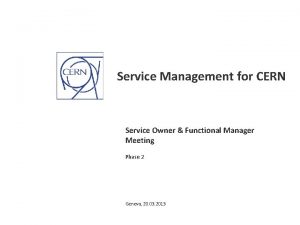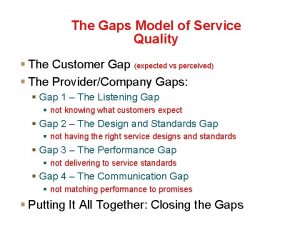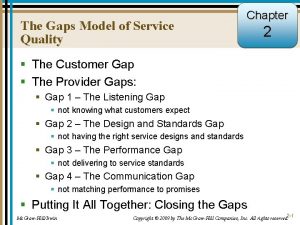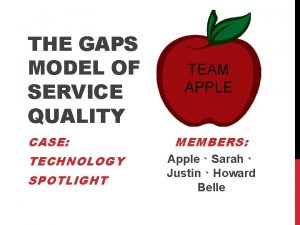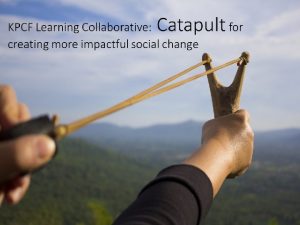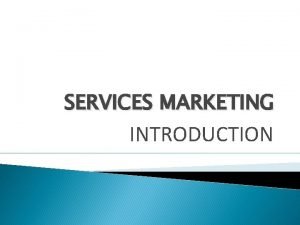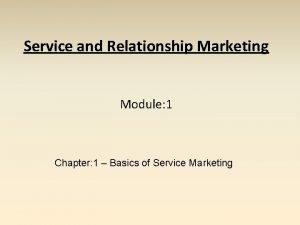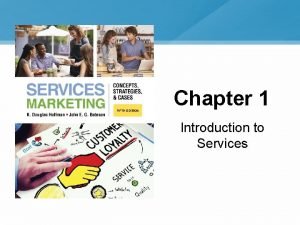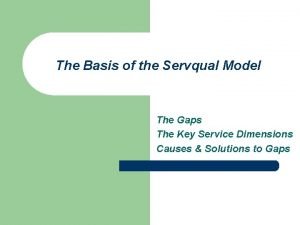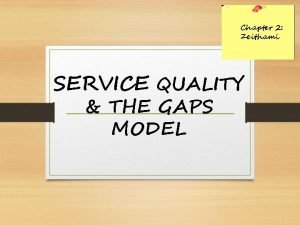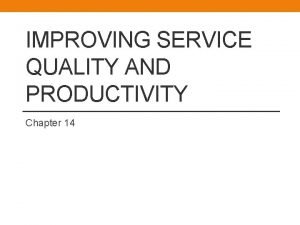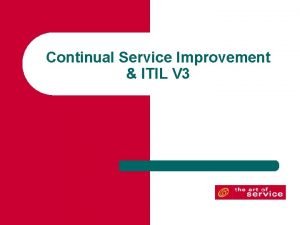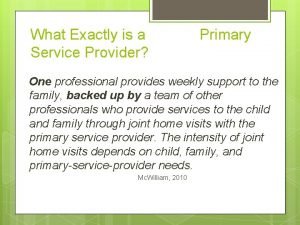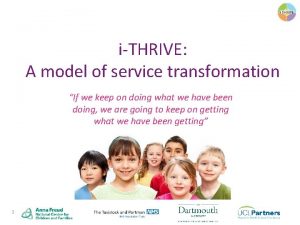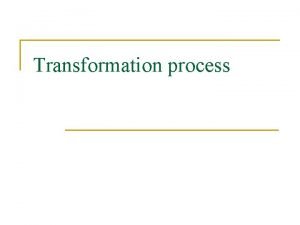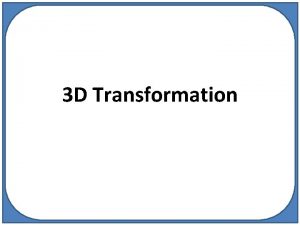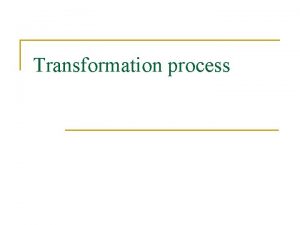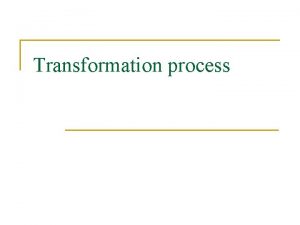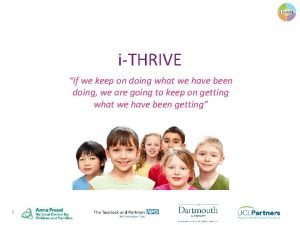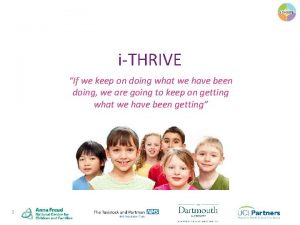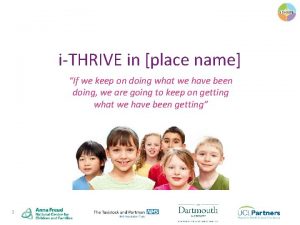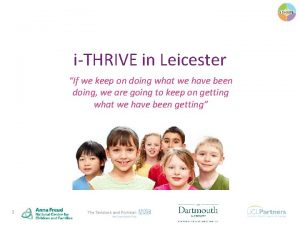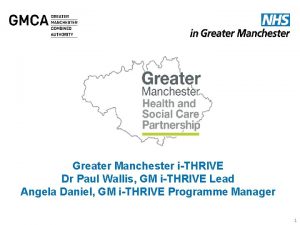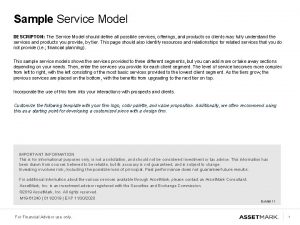iTHRIVE A model of service transformation If we









































- Slides: 41

i-THRIVE: A model of service transformation “If we keep on doing what we have been doing, we are going to keep on getting what we have been getting” 1

Overview of the THRIVE Conceptual Framework 2

Future In Mind and the FYFV for Mental Health By 2020, for people of all ages we want to see: Improved crisis care for all ages: right place, right time, close to home Improved transparency, leadership and accountability across whole system More visible and accessible support Improved public awareness less fear, stigma and discrimination Timely access to clinically effective support More evidence based, outcome-focused treatments Better use of data and information across the network And for children and young people specifically: Professionals who work with children and young people trained in child development and mental health Model built around the needs of children and young people, and a move away from the ‘tiers’ model Peter Fonagy, 2018. 3 Improved access for parents to evidence-based programmes of intervention and support A better offer for the most vulnerable children and young people Publications Gateway Ref. No. 03250

We know what makes it work better AC Improving access CO UN TA BI Improving outcomes accountability LI C C A S & engagement S E TY Delivery of evidencebased practices EBP AWA PARTICIPATION Increasing MH REN ESS awareness & decreasing stigmatisation Enhancing youth, carer and community participation www. england. nhs. uk Peter Fonagy, 2018.

The THRIVE Conceptual Framework The THRIVE conceptual framework (Wolpert, et al. 2016) was developed as a collaboration between the Anna Freud National Centre for Children and Families and the Tavistock and Portman NHS Foundation Trust. Built on learning from: • Child Outcomes Research Consortium (CORC); use of patient reported outcome measures to transform practice: www. corc. uk. net • Choice and Partnership Approach (CAPA); how to manage flow and embed shared decision making: http: //capa. co. uk/ • Payment Systems in CAMHS development; 19 case mix adjusted groupings: http: //pbrcamhs. org/final-report-published/ 5

The THRIVE Conceptual Framework: Latest Iteration (November 2016) THRIVE was originally authored by professionals involved in mental health support for children and young people, all of whom came from a health background. THRIVE Elaborated (Second Edition) now has co-authors from the world of education and social care, and have drawn on views from head teacher panels, CCG leads and local authority directors. Highlights four key ways in which the THRIVE Framework is inherently multiagency: 1. THRIVE endorses multi-agency definitions of mental health promoting practices 2. THRIVE encourages shared multi-agency responsibility for promoting “thriving” 3. THRIVE promotes multi-agency proactive “advice” and “help” 4. THRIVE supports multi-agency clarity on endings as well as beginnings THRIVE Elaborated, Second Edition (Wolpert et al. , 2016) 6

The THRIVE Conceptual Framework • Distinction between advice/support and evidence based ‘treatment’ • The five needs based groups are distinct in terms of the: o needs and/or choices of the individuals within each group o skill mix of professionals required to meet these needs o resources required to meet the needs and/or choices of people in that group THRIVE Elaborated, Second Edition (Wolpert et al. , 2016) 7

THRIVE Key Principles • Shared decision making at heart of choice • Acknowledgment of limitation of treatment • Acknowledgment of limitations of resources • Distinction between treatment and risk support • Greater emphasis on how to help young people and communities build on their own strengths 8 THRIVE Elaborated, Second Edition (Wolpert et al. , 2016)

Thriving: Theory • Context: All children, young people and their families not currently needing individualised mental health advice or help are considered to be thriving. THRIVE would suggest that this group receive community initiatives that support mental wellness, emotional wellbeing and resilience of the whole population. • Data: Around 80 -90% of the total population of children and young people. • Resource: In many areas around 10 -15% of budgets in children and young people’s metal health services are allocated to support community resilience programmes; consultation with teachers, health visitors and others; and other forms of intervention to support widespread wellbeing and mental health. • Provision: The THRIVE framework expects that the system actively applies research evidence of the kind of interventions that are likely to reduce the risk of developing mental health difficulties and promote wellbeing and mental health: o Universal prevention: Targeting the general public or a population group that has not been identified on basis of individual risk o Selective prevention: Targeting individuals or population subgroups who have risk factors placing them at a higher than average risk of developing mental health needs 9

Thriving: In Practice • Linking with public health, local communities and a wide range of agencies required to promote wellbeing • Consideration required in relation to how information will be disseminated through schools, online, youth programmes, children’s centres etc • Potential opportunity to incorporate Thriving into existing universal assessment and intervention mechanisms such as ‘redbooks’ • Universal materials to support Thriving which can be disseminated across the system • Targeted interventions for groups of children and young people that we know are more likely to need support with their mental health 10

Getting Advice and Signposting: Theory • Context: Children, young people and families who may require temporary support within the community or advice to self-manage long-term conditions for those who choose to do so. • Data: Modal number of sessions in CAMHS is one. Practitioner reports suggest that some find just a single contact with services enough to normalize behavior and provide them with reassurance they are doing the right things to resolve the problem. • Resource: If it is estimated that 30% of children and young people needing specialist support would benefit from only small amount of resource, then this group would account for 8% of total spend and staff time. • Provision: Support in ‘Getting Advice’ can be provided in a range of settings including health, local authority, schools, social care and third sector. Input should involve some of the most experienced mental health workforce to determine how best to help. Local databases can help to identify relevant community and digital resources. Support should build on existing family resources and self-management promoted through information provision. THRIVE suggests an invitation to recontact services after advice is given in case things do not improve could be made. 11

Getting Advice and Signposting: In Practice • Breaking down barriers and linking services to provide integrated care • Multi-agency assessments are supported by senior mental health staff • Digital offer for information, support and guidance • Established community network of providers – choice of support for children, young people and their families • Mental health support accessible in schools and primary care • Early guidance to ensure the right treatment and the right time • Focus on early intervention to build resilience and influence outcomes positively 12

Getting Help: Theory • Context: The children, young people and families who would benefit from focused, evidence-based treatment. • Data: Of the 60% of children, young people and their families who were assigned to ‘Getting Help’ only half were receiving care aligned to specific NICE guidance. • Resource: The mean number of face-to-face contacts was 7. • Provision: The THRIVE Framework places a greater emphasis on ending interventions when they are not working. Input might draw on specialised technicians in different treatments. Treatment would involve explicit agreement from the beginning about the outcome being worked towards and the likely timeframe. There would be a plan for what happens if it is not achieved. 13

Getting More Help: Theory • Context: The children, young people and families who would benefit from extensive long-term treatment. Some conditions such as psychosis, eating disorders and emerging personality disorders are likely to require this input. • Data: This group makes up 5% of children, young people and their families receiving input, but accounted for 39% of appointments. The average number of appointments attended is estimated to be around 10. • Resource: The range of costs within the group is likely to be very wide. • Provision: More procedurally defined interventions could be provided by less highly trained practitioners than are required for ‘Getting Advice’. 14

Getting Help and Getting More Help: In Practice • Establishing a common language • Importance of evidence based practice • Need for high quality outcomes which help to build an evidence base • The need for more defined interventions rather than open ended treatment • Clear goals identified at the beginning of treatment, with a plan in place for what happens if those goals are not met • Better communication across physical health, social care and other agencies 15

Risk Support: Theory • Context: Children, young people and families for who evidence-based treatment are not demonstrating changes in outcomes. There are often severe needs which can be long term and cross-generational. There can be limited resources (financial and human) and limited capacity to cope with family and life pressures, alongside poor problem solving skills coupled with a lack of intrafamiliar social support. There can be significant mental health issues, particularly substance misuse, domestic violence and physical health needs. • Data: It is estimated that this group account for 5 -10% of all young people currently accessing services, although it is currently hard to differentiate them from children, young people and families receiving interventions from ‘Getting Help’ and ‘Getting More Help’. • Resource: Practitioner reports suggest this group requires significant input, time and energy. Many may be being offered intensive treatments but not attending appointments and/or not making progress. They may routinely go into crisis or self-harm. • Provision: The THRIVE Framework suggests there needs to be close interagency collaboration and clarity on who is responsible. 16

Risk Support: In Practice Whole system change required with buy in from key stakeholders Would enable better support for staff with complex cases Shared responsibility across agencies Supporting cases that aren’t traditionally in each other’s territories • Facilitating conversation with children, young people and their family’s to help them identify their own needs • Early guidance to ensure right treatment and right time • • 17

FAQ: What’s the difference between Getting More Help and Getting Risk Support? Getting Help or More Help • Evidence-based, carefully designed and tested for fidelity • Aim of recovery, or goal of improvement expected to enhance wellbeing • Participants committed to achieving change • Focused activity with predetermined timeframes • Structured with a theoretical rationale based on understanding of the disorder • Modification to the treatment protocol is indicated by session treatment response 18 Getting Risk Support • Individually tailored support based on an explicit collaborative shared plan for each family • Aim of reducing the risk of harm, serious incidents, and decreasing the chance of deterioration as well as increasing selfmanagement, resilience and agency • Participants committed to improving their reactions to crises • Ongoing process dependent on the young person’s needs • Pragmatically driven; family to influence structure and content of the intervention within legal constraints • Modification to the agreed protocol is a regular occurrence in response to the safety outcomes achieved

The THRIVE Conceptual Framework: Summary The THRIVE Framework: • replaces tiers with a whole system approach • is based on the identified needs of children, young people and their family’s • advocates the effective use of data to inform delivery and meet needs • identifies groups of children and young people and the types of support they need • draws a clearer distinction between treatment and support • builds on individual and community strengths wherever possible • ensures children, young people and their families are active decision makers THRIVE Elaborated, Second Edition (Wolpert et al. , 2016) 19

Implementation examples of key principles • • Unity Radio, Manchester Social Mediation and Self-Help in Schools, Humber #Thrive service in Rochdale Camden CAMHS in Schools Service Resilience in Schools Programme, Luton Manchester and Salford’s Integrated Pathway THRIVE-like Specification, Warrington Embedding THRIVE needs based groups in electronic records 20 • • • Meeting the needs of parents Getting Advice and Signposting, Havering Cheshire and Wirral Partnership CAMHS Choice Clinic Next Steps Cards, Cheshire and Wirral Haringey’s First Step Service Examples of best practice: Digital front end • • • Approach to Risk Support in Camden THRIVE Clinic, Waltham Forest Camden Model of Social Care Waltham Forest Long Term Conditions Clinic Greater Manchester’s Eating Disorder Pathway • • Developing and piloting i. THRIVE Grids Using i-THRIVE Grids to improve shared decision making

Q & A: your thoughts on the THRIVE Conceptual Framework 21

Implementing THRIVE 22

The response to the THRIVE Conceptual Framework We really like the concept and principles of THRIVE and would like to use it to underpin our redesign of mental health services for children and young people in line with Future in Mind BUT… What do the principles look like in practice on the ground? Can we access support for implementation? 23 How do we make it work in our area? How should we design services to reflect THRIVE principles? Is there a blueprint for implementation? How do we implement the concepts?

i-THRIVE Programme i-THRIVE is the implementation programme that supports sites to translate the THRIVE Conceptual Framework into a model of care that fits local context. The i-THRIVE Programme is a collaboration between the Anna Freud National Centre for Children and Families, the Tavistock and Portman NHS Foundation Trust, Dartmouth Institute for Health Policy and Clinical Practice, and UCLPartners. 24

i-THRIVE is a ‘Whole-Systems Approach’ • Delivering good quality care that is efficient cannot be achieved successfully by looking at a single service or set of professionals, rather it needs to consider all the parts of the system. • This involves not only thinking about all the agencies that are involved in providing services, but also considering how well the different ‘levels’ of the system are working together. • One way of thinking about these levels is to think about it in terms of three parts, all of which are dependent on each other and interact with each other. • These are the ‘Macro’, ‘Meso’ and ‘Micro’ systems. • THRIVE focuses on providing care according to the needs of young people, and helps services to provide that care according to those needs identified. • Given this, when developing a view of the system, it is necessary to understand which patient groups that are being considered at each level in the system, as well as the services that are providing care to that patient group at that level. 25

i-THRIVE Approach to Implementation: whole system change MACRO Consideration of Population Health Improvement How agencies work together and commission services for the population MESO Needs based groups of young people and the services/ teams that enable delivery of care according to those needs MICRO Ways of working with young people and their families, and how professionals can work best in a collaborative and integrated way 26

i-THRIVE Approach to Implementation: whole system change 27

Core Components of an i-THRIVE Model of Care 28

Components of an i-THRIVE Model of Care: Shared Decision Making Shared decision making at + each point in pathway i-THRIVE Grids • Project funded by the Health Foundation to adapt Dartmouth Option Grid decision aid into a new grid for CAMHS settings • Six grids created after significant engagement with young people, parents, clinicians and other partners and piloted in Camden from February – August 2017 • Collabo. RATE measure used to collect baseline data and to measure change as a result of introduction of i-THRIVE Grids along with qualitative feedback from young people, parents and clinicians 29

Components of an i-THRIVE Model of Care: Shared Decision Making 30

THRIVE Illustrated: Case Studies 31

Support available to i-THRIVE sites 32

i-THRIVE National Programme: offer to sites Funded projects Individual projects, e. g. , to create and test shared decision making aids in Camden, and the implementation of THRIVE in NELFT Evaluation Two year evaluation of i-THRIVE accelerator sites i-THRIVE Toolkit Evidence based tools to aid implementation i-THRIVE Approach to Implementation Four phase approach to implementation developed from implementation science evidence base 33 Direct support to sites From the national programme team: Includes regular liaison, consultation and practical support i-THRIVE Academy Learning and development support and training modules for sites THRIVE Illustrated Series of case studies highlighting how sites have approached the implementation of THRIVE i-THRIVE Community of Practice Nation-wide shared learning events and forum for sites to share experiences about implementing THRIVE

Learning from the i-THRIVE Community of Practice 10 national accelerator sites in October 2015 75 48% CCG areas by August 2018 318 individuals in the Community of Practice 20% health commissioner 53% health provider 10% local authority 6% voluntary sector 4% education shared learning events held 7% other attended by over 8 34 340 of children and young people within England

i-THRIVE Approach to Implementation 35

Support for implementation sites A range of tools to support an evidence based approach to implementation in line with the i-THRIVE approach. Available at www. implementing. THRIVE. org Pathway mapping Quantitative data Qualitative data THRIVE Assessment Tool Gap analysis Prioritising areas for improvement Redesign Implementation planning 36

i-THRIVE Academy Pilots in March and April 2017: Four learning and development modules created based on key competencies required to deliver care in a THRIVE-like way 214 Professionals from across the system of support for children and young people’s mental health 66% health 18% local authority 4% education 6% third sector 6% other Shared Decision Making When to Stop Treatment 37 from 56 organisations covering 30 16. 3% CCG areas that are responsible for Risk Support Getting Advice: Assessment and Signposting of children and young people in England

Using the i-THRIVE Grids to improve shared decision making Pilot training module evaluation: Five two-hour training sessions were delivered to a total of 35 mental health professionals from February to May 2018 “Shared decision making is important and we should strive to work in this way and be flexible to make it work” Other 21% Participant role “Importance of using more tools that help service users to be part of decisionmaking process” Service Manager 4% Senior Leadership 4% “[We] need to empower children/young people by broadening options and being open to their views” Clincian 71% Participant ratings pre- vs. post-training (range: 0 to 4) 3. 5 3 2. 5 2 1. 5 1 0. 5 0 38 Readiness to use the i. THRIVE Grids Confidence in Current knowledge of explaining shared the i-THRIVE Grids shared decision making to a third party Pre-training Post-training “[I will] use the grids in triage appointments to facilitate conversations on treatment options”

Q & A: your thoughts on the i-THRIVE programme i-THRIVE Team 39

For more information: i-THRIVE www. implementingthrive. org Sign up to the national i-THRIVE Community of Practice and receive monthly updates. Email Bethan Morris at: bethan. morris@annafreud. org @i. THRIVEinfo 40

For more information: the national i-THRIVE Programme Team: Rachel James: i-THRIVE Clinical Lead rjames@tavi-port. nhs. uk Bethan Morris: i-THRIVE Research Officer Bethan. morris@annafreud. org Emma Louisy-Scott: i-THRIVE Programme Manager ELouisy@Tavi-Port. nhs. uk 41 On secondment
 Ithrive model
Ithrive model Ithrive model
Ithrive model Ithrive model
Ithrive model Factors stimulating the transformation of service economy
Factors stimulating the transformation of service economy Factors stimulating the transformation of service economy
Factors stimulating the transformation of service economy Transformation process in operation management
Transformation process in operation management Formal transformation model
Formal transformation model Input-transformation-output model examples
Input-transformation-output model examples Inputs outputs transformation processes and feedback
Inputs outputs transformation processes and feedback Transformasi formal
Transformasi formal Service v model
Service v model Itil service lifecycle stages
Itil service lifecycle stages 7 step improvement process
7 step improvement process Lasting service intensifiers
Lasting service intensifiers Soa architecture
Soa architecture Mpls class of service
Mpls class of service New service concept design
New service concept design Service owner vs service manager
Service owner vs service manager Help desk improvement plan
Help desk improvement plan Adp employee self service registration
Adp employee self service registration Concentric zone theory
Concentric zone theory Provider gaps
Provider gaps Provider gap 1
Provider gap 1 Gaps model for improving service quality
Gaps model for improving service quality Social work service delivery models
Social work service delivery models Shostack molecular model
Shostack molecular model Goods and services examples
Goods and services examples Health and safety images free download
Health and safety images free download Lovelock flower of service model
Lovelock flower of service model Horizontal communication
Horizontal communication Provider gap 1
Provider gap 1 Russell model affect service marketing
Russell model affect service marketing The flower of service
The flower of service Waiting cost queuing theory
Waiting cost queuing theory Push-in service delivery model
Push-in service delivery model Three stage model of service consumption
Three stage model of service consumption Gaps model for improving service quality
Gaps model for improving service quality Itil benchmark metrics
Itil benchmark metrics Pekka kähkipuro
Pekka kähkipuro Primary service provider model
Primary service provider model Help desk maturity model
Help desk maturity model Transforming hr service delivery at kellogg
Transforming hr service delivery at kellogg
